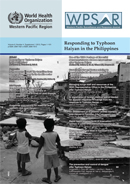The prevention and control of dengue after Typhoon Haiyan
DOI:
https://doi.org/10.5365/wpsar.2015.6.3.HYN_018Abstract
Objective: Many of the areas in the Philippines affected by Typhoon Haiyan are endemic for dengue; therefore, dengue prevention was a priority in the initial post-disaster risk assessment. We describe the dengue prevention and response strategies applied after Haiyan.
Methods: The dengue response was implemented by a wide range of national and international stakeholders. Priorities included the rapid re-establishment of an effective surveillance system to quickly identify new dengue cases, monitor trends and determine the geographical distribution of cases. Dengue rapid diagnostic tests (RDTs) were distributed to sentinel health facilities, and comprehensive vector control activities and entomological surveys were implemented. Several training sessions for key stakeholders and awareness campaigns for communities were organized.
Results: There were RDT-positive dengue cases reported from urban and semi-urban areas where entomological surveys also confirmed a high density of Aedes aegypti mosquitoes. Although there was an increase in dengue cases in January 2014, the number of cases remained below the epidemic threshold throughout the remaining months of 2014.
Discussion: There was no large outbreak of dengue after Haiyan, possibly due to the targeted, multifaceted and rapid response for dengue after Haiyan. However, surveillance differed after Typhoon Haiyan, making comparisons with previous years difficult. Multiple players contributed to the response that was also facilitated by close communication and coordination within the Health Cluster.

